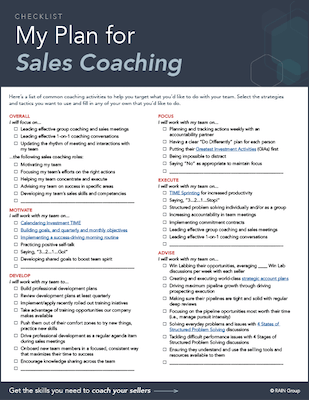It’s always important to remember: if you don’t know where you’re going, any road will get you there.
If you want your sellers to perform at the peak of their potential, it’s essential to know the specific objectives you need to help your team achieve, and to map out the road that will help them achieve those objectives.
This is the purpose of RAIN Group’s My Coaching Plan: to allow you to very quickly map out what you want to do to unleash your sales team’s potential and build a specific action plan to get them there.
There are five sections to My Coaching Plan:
Here we break them down and provide examples of each.
1. What Sellers Should Do Differently
It’s critical to figure out what sellers on your team should do differently, seller by seller, so you know where you want to take them to improve their results.
For example, Sandra Jones is prospecting intermittently for 3 to 5 hours a week. If she were to prospect for eight hours a week in focused sprints, she would not only double her prospecting time, but also more than double her output. When she gets in the zone and achieves flow, she’ll get more prospecting done and achieve better results for each hour she spends.
The impact of this will be for her to go from setting two meetings per week to five, so in about three months she’ll have doubled her weighted average pipeline.
Sandra also isn’t laser focused on her top three accounts, but if she had plans to grow them, and she executed against those plans, she would likely grow those accounts from $500,000 per year to $1.2 million per year.
|
What should individual sellers on my team do differently? |
|||
| Name | Sandra Jones | ||
| Doing Now |
|
||
| Do Differently |
|
||
| Impact |
|
||
The idea is to do this for each seller on your team. It’s perfectly fine for you to come up with ideas yourself, but it’s much more effective if you have facilitated meetings with your sellers to identify the areas that could have the greatest impact on their results, and allow the sellers to create their own plans, which you can then help them finish.
Choice drives motivation. If sellers come up with the plans themselves, they’ll own them.
Next, you want to do the same for your team. Thinking in general across all team members, what shared priorities would make the biggest difference?
For example, across your team, perhaps the most important opportunity pursuits aren’t organized, aren’t strategized to craft the best plan to win, and, without strong sales opportunity plans in place, are lacking strong execution.
If each person identified which top pursuits to Win Lab—the process we at RAIN Group use for deal reviews—then plans would be in place to win major sales, and the team would have clear action plans, or task clarity, on what to do to win.
In doing this, the team win rate on proposed sales might jump from 44% to 51%—or 7 percentage points—resulting in the whole team beating their annual sales plan.
|
What should my team as a whole do differently? |
|||
| Doing Now |
|
||
| Do Differently |
|
||
| Impact |
|
||
Keep the priorities on this list to no more than five, and if you identify more than five, only act on the smallest list of priorities at a time. You can almost always achieve them one by one, but it’s difficult to achieve too many at one time.
2. Coaching Conversation and Meeting Rhythm
Every day you may have a quick check-in to make sure plans for the day are set, any major issues or challenges are surfaced, and all questions are answered. Whether you do this daily or three times per week depends on your team. In our experience, at least three times per week on a set schedule with each seller keeps accountability and focus highest and helps to develop strong and trusting relationships.
As these are 10 minutes per day, we averaged it to one hour total per week.
| My Sales Coaching Rhythm
Develop or refine your sales meeting coaching rhythm. |
Hours Per Week |
| Daily Meetings | |
|
1 |
| Weekly Meetings | |
|
2.5 |
| Bi-Weekly Meetings | |
|
.75 |
| Monthly Meetings | |
|
.25 |
| Quarterly Meetings | |
|
Less than .25 |
| Average time in meetings per week per seller | Approx. 5 hours |
Weekly you might have a:
- 10-minute check in specifically on accountabilities for the week
- Scheduled deal review
- Weekly team sales meeting
This averages to about two and a half hours per week.
On average, each member of your team is in meetings with you for about five hours every week. This number is important because you want to maximize your team’s time selling and keep them on track while helping them succeed during their meetings with you.
3. Coaching Checklist
Here’s a summary of common coaching activities to help you target what you’d like to do with your team. Select the strategies and tactics you want to use and fill in any of your own that you’d like to do. Download our ebook, Unlocking the Productivity Code, for more details on the activities listed here.
4. Seller Development Plan
You’ll want to capture areas for development focus in a Skill Development Plan. Again, this is done by individual seller and will help guide your conversations with that individual to help them develop their skills.
| Seller Name: Tony Mann | Last Updated: October 22 |
| Overall Areas for Development Focus |
|
|
|
|
| Skills, Knowledge, Attributes | Proficiency Low 1 — 5 High |
Plan to Develop Including training and coaching |
Testing for proficiency | |
| Now | Target | |||
| Skills | ||||
| Influencing Buyer Agenda | 3 | 4 | Advanced Consultative Selling skills training | Call Reviews |
| Knowledge | ||||
| Insight about financial services industry | 3 | 5 | Weekly reading and discussion of industry news; get subscription to 2 leading magazines | Discussions during coaching; knowledge share to team at monthly meetings |
| Attributes | ||||
| Motivated and productive | 2 | 4 | Attend 9 Habits of Extreme Productivity program | Weekly action plans and reviews; calendaring Investment time |
5. Priorities and Actions
Finally, summarize everything, including an implementation plan.
For example, you’ll want to include:
- Your accountability partner, a person you’ll check in with each week, sharing your priorities and reporting on what you accomplish (and didn’t accomplish) in the week prior.
- Your top priorities.
- Your objectives this month (be sure to make sure they align with your top priorities)
It might look something like this:
| My Accountability Partner's Name | Marty James |
| Report Progress on (Day / Time) | Fridays at 12:00 |
| Top 3 to 5 Priorities Next 90 Days No more than 5. Star/Bold the most important priority. |
|
| Objectives This Month Keep list short. Star/Bold the most important priority. |
|
How My Coaching Will Be Different is very important to write out. In our experience, coaches who don’t do this easily slip into the same coaching motions they’ve done in the past. But if you write down these actions, you can do your own accountability checks to make sure you stay on target as you review the plan.
| How My Coaching Will Be Different What I will change to make my coaching most effective. |
|
| Success Metrics How I'll measure progress and know I'm successful. |
|
Action Plan. These are specific to-do items that you need to execute to make sure the plan comes alive for yourself and your team.
| Action Plan Specific next steps for implementing My Coaching Plan. |
||||
| What | When | Status | ||
| Not Yet Started | In Progress | Complete | ||
| Set up weekly plans and accountability checks with team | Sales meeting this week | ☐ | ☒ | ☐ |
| Roll out coaching rhythm and schedule individual meetings | Sales meeting this week and just after | ☐ | ☒ | ☐ |
| Create a schedule of rolling out strategies and hacks to use with team from the Coaching Checklist; add each agenda for next 3 months of sales meetings in 15-minute segments | October 28 | ☒ | ☐ | ☐ |
| Ride along or review recordings of needs discovery meetings of each team member and create improvement plans | November 1 | ☒ | ☐ | ☐ |
As you finish your plans, ask yourself, “If I actually execute the plan, will it make a positive difference, achieve the improvement metrics, and bring my team to another level?”
If the answer is no, keep working on the plan until you get there.
If it’s yes, it’s time to implement with action and accountability.








